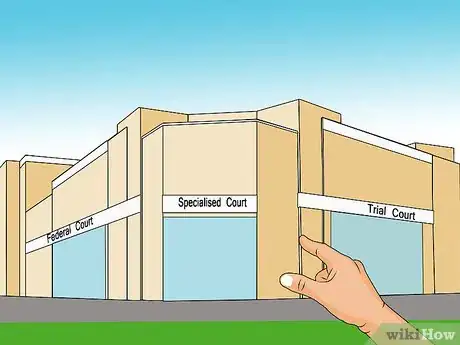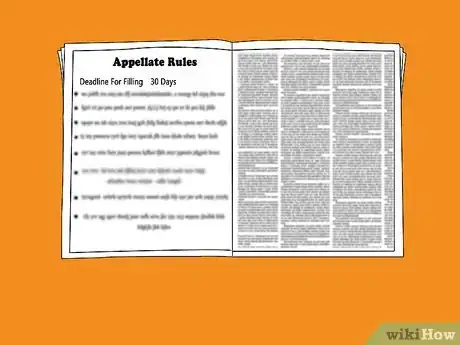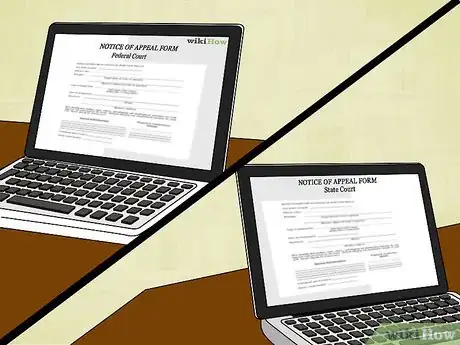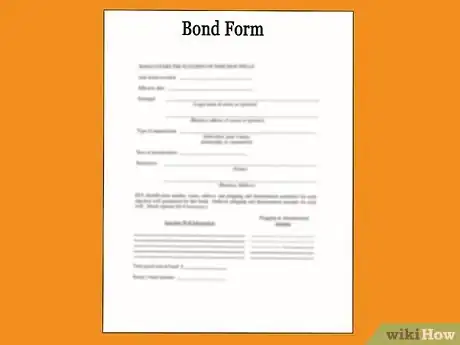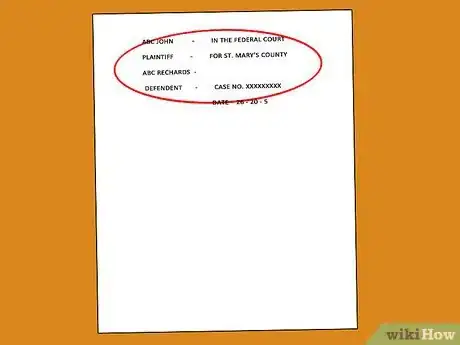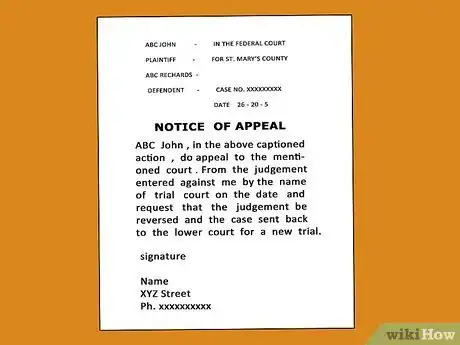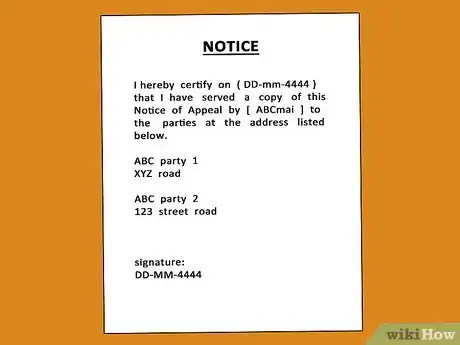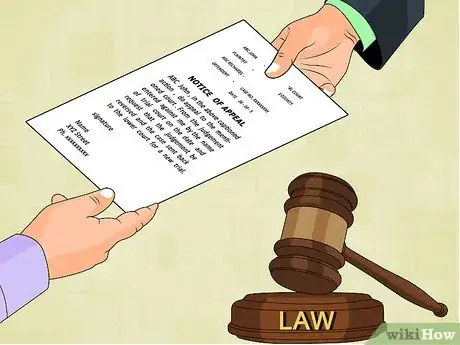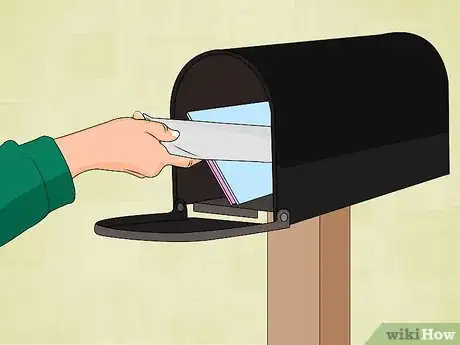This article was co-authored by Clinton M. Sandvick, JD, PhD. Clinton M. Sandvick worked as a civil litigator in California for over 7 years. He received his JD from the University of Wisconsin-Madison in 1998 and his PhD in American History from the University of Oregon in 2013.
This article has been viewed 36,087 times.
When a trial ends, usually at least one party is unhappy with the result. If that party wants another court to review the trial record, then they can appeal the decision to the next higher court by filing a letter, or notice, of appeal. Fortunately, almost every case can be appealed at least once. You must notify the courts and the other parties, and you do this by preparing, filing, and serving a Notice of Appeal in a timely fashion.
Steps
Gathering Information
-
1Locate the appropriate appellate court. Every court sits in a hierarchy made up of other courts. You appeal a court's decision to the court that sits directly above it. If you do not know which court to appeal to, ask the judge after he has issued his ruling or check with the clerk court.
- In the federal court system, district court decisions are appealed to the circuit courts, whose decisions may be appealed to the Supreme Court.[1]
- In state courts, trial court decisions are generally appealed to intermediate appellate courts, who in turn may be appealed to the state’s Supreme Court.
- There are many exceptions. For example, specialized courts exist at both the state and federal level. A federal bankruptcy court’s decisions are often appealable to the district court or to a special Bankruptcy Appellate Panel.[2]
-
2Read the appellate rules. Each court has rules for proper formatting as well as deadlines. You should get the rules and read them.
- Pay close attention to deadlines for filing. If you miss the deadline, a court will dismiss your appeal.
- Deadlines vary by state and court. In Illinois civil cases, you have 30 days from the date of the final judgment entered into the trial court.[3] In California, you typically have 60 days.[4] But in Pima County, Arizona you only get 14 days. Because the deadlines can vary, it is critically important to find and read the appellate rules for the court you are appealing to.
- Typically, you can find rules on the internet. Texas, for example, has a PDF you can download.
Advertisement -
3Find a Notice of Appeal form. Many courts have pre-printed forms which you can fill out and file as your Notice of Appeal. Even if your court does not have a pre-printed form, you can use one as a model for creating your own.
- There are many examples on the internet of forms for federal and courts.
-
4Seek a bond. If you lost at trial, then the plaintiff can move to enforce its judgment against you even though you have the right to an appeal. The plaintiff could garnish your wages or put a lien on property. If you win on appeal, you can get the money back, but the plaintiff may have spent it already or else be insolvent.
- The bond prevents the creditor from garnishing assets during the pendency of the appeal. Unless you can put sufficient cash in escrow, you may have to secure a bond from a third party.[5]
- To secure a bond at a favorable rate, you should meet with banks you already do business with and discuss getting a bond.[6]
Drafting the Notice of Appeal
-
1Copy the caption. The caption is the heading of a legal document. It lays out the parties, the case number, and the name of the court hearing the case.
- Almost every document that you file should have the same caption. Simply copy this information and format it into a new document.
- In some jurisdictions, you will use the name of the court which will hear the appeal instead of the name of the court that heard the trial. Check with your appellate rules.
-
2Insert the title. Two lines below the bottom of the caption center the words "Notice of Appeal." Make the words bold.
-
3Compose the body. The body of the notice should tell the court what you are appealing. Include the following information:
- Your name and the case you are appealing from (e.g., “I, John Smith, in the above captioned action…”)
- The court you are appealing to (e.g., “…do appeal to the [insert name of the appellate court]…”
- The order you are appealing and the court which issued it (e.g., “…from the judgment entered against me by the [name of the trial court] on [the date]…”)
- Request for relief: what you want the appellate court to do (e.g., “…and request that the judgment be reversed and the case sent back to the lower court for a new trial.”)
-
4Insert signature block. Beneath the body, insert room for your signature. Underneath the signature line, type your full name, address, and telephone number.
-
5Append a Certificate of Service. You must serve the other parties in your lawsuit notice that you intend to appeal. You can do this by sending them copies of your completed Notice of Appeal. You must certify to the Court that you have notified them.
- You can give notice in several ways. For example, many courts allow for notice by mail. If you can serve notice by mail, type, "I hereby certify on [the date] that I have served a copy of this Notice of Appeal by [U.S. mail or another carrier] to the parties at the addresses listed below." Then list the parties, including their addresses, and sign and date the certification.
- If you choose to mail, be sure to send by certified mail.
- You may also hire a process server to deliver the notice, or deliver it yourself. In this case, type, "I hereby certify on [the date] that the attached Notice of Appeal was delivered by hand to the parties listed at the addresses below.” Then list the parties and their addresses, followed by your signature and the date.
-
6File the Notice of Appeal. You can hand deliver it to the court. Typically, you will file the Notice with the court from which you are appealing. The clerk should direct you to the right court.
- If you file in person, be sure to take copies of the Notice and have them time-stamped. You will keep a copy for your records but also send a stamped copy to the other party.
-
7Pay fees. In most jurisdictions, you must pay a fee for filing a notice of appeal. Call ahead to ask for the amount as well as acceptable methods of payment.
- If you are posting a bond, then take the bond with you. You can post it at the same time that you file your notice of appeal. Ask the clerk how.
-
8Serve the notice on the other parties. Put a time-stamped copy of the Notice in an envelope and mail it. You may also have it served.
- Send by certified mail so that you have proof that the Notice was received.
Warnings
- Filing the Notice of Appeal is only the first step in the appeals process. You also need to file a brief, in which you make the legal arguments for why the lower court was wrong. This brief has its own filing deadlines you must meet.⧼thumbs_response⧽
References
- ↑ http://www.uscourts.gov/FederalCourts/UnderstandingtheFederalCourts/FederalCourtsStructure.aspx
- ↑ http://www.uscourts.gov/FederalCourts/UnderstandingtheFederalCourts/CourtofAppeals/BankruptcyAppellatePanels.aspx
- ↑ http://www.illinoislegalaid.org/index.cfm?fuseaction=home.dsp_content&contentID=6651
- ↑ http://www.courts.ca.gov/cms/rules/index.cfm?title=eight&linkid=rule8_104
- ↑ http://www.mayerbrown.com/Files/Publication/6bad18b5-dc12-4b18-9ae6-b54c085d288e/Presentation/PublicationAttachment/1cf8758c-3149-4b70-8bfe-e3ded5e97248/FTD-1201-BishopYountGrewell.pdf
- ↑ http://www.mayerbrown.com/Files/Publication/6bad18b5-dc12-4b18-9ae6-b54c085d288e/Presentation/PublicationAttachment/1cf8758c-3149-4b70-8bfe-e3ded5e97248/FTD-1201-BishopYountGrewell.pdf
About This Article
Before you write a letter of appeal, find your court’s premade Notice of Appeal form and fill it out, with the parties, case number, and the name of the court on top, and “NOTICE OF APPEAL” below. Once you’ve filled out the top of the page, compose the body of the letter, starting with your name and the name of the court you’re appealing to. Then, list the order you’re appealing, the court that issued it, and what you want the appellate court to do. To learn our Legal reviewer’s advice on how to notify any other involved parties that you intend to appeal, keep reading!
